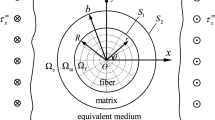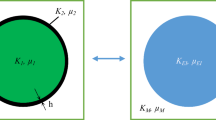Abstract
An analytical method is proposed to solve the problem of an infinite elastic matrix containing a doubly periodic array of coated cylindrical inclusions under antiplane shear. The elastic fields in the inclusions, the coatings/interphases and the matrix are derived, which are used to investigate the stresses and the effective stiffness coefficients of the nanofiber composites. Numerical examples demonstrate the size dependence of the stress and the effective stiffness coefficient, and the effects of the interphase thickness and stiffness and array configurations of the inclusions on the effective stiffness coefficient. A finite element analysis is used to benchmark the effective stiffness coefficient predicted by the proposed model, in which excellent agreement is observed. When letting the interphase be thin enough, the proposed coated inclusions model can be used to simulate the zero-thickness interface model, which is validated by the results comparisons of the two models. Instabilities of the stress fields are observed under certain conditions in simulating the zero-thickness interface model.















Similar content being viewed by others
References
Paliwal, B., Cherkaoui, M.: Estimation of anisotropic elastic properties of nanocomposites using atomistic–continuum interphase model. Int. J. Solids Struct. 49(18), 2424–2438 (2012)
Wong, E.W., Sheehan, P.E., Lieber, C.M.: Nanobeam mechanics: elasticity, strength, and toughness of nanorods and nanotubes. Science 277(26), 1971–1975 (1997)
Mogilevskaya, S.G., Crouch, S.L., Stolarski, H.K.: Multiple interacting circular nano-inhomogeneities with surface/interface effects. J. Mech. Phys. Solids 56(6), 2298–2327 (2008)
Li, Y., Waas, A.M., Arruda, E.M.: A closed-form, hierarchical, multi-interphase model for composites—derivation, verification and application to nanocomposites. J. Mech. Phys. Solids 59(1), 43–63 (2011)
Dingreville, R., Qiu, J.M., Cherkaoui, M.: Surface free energy and its effect on the elastic behavior of nano-sized particles, wires and films. J. Mech. Phys. Solids 53(8), 1827–1854 (2005)
Paliwal, B., Cherkaoui, M., Fassi-fehri, O.: Effective elastic properties of nanocomposites using a novel atomistic–continuum interphase model. C. R. Mec. 340(4–5), 296–306 (2012)
Odegard, G.M., Clancy, T.C., Gates, T.S.: Modeling of the mechanical properties of nanoparticle/polymer composites. Polymer 46(2), 553–562 (2005)
Gurtin, M.E., Murdoch, A.I.: A continuum theory of elastic material surfaces. Arch. Ration. Mech. Anal. 57(4), 291–323 (1975)
Gurtin, M.E., Murdoch, A.I.: Surface stress in solids. Int. J. Solids Struct. 14(6), 431–440 (1978)
Tian, L., Rajapakse, R.K.N.D.: Elastic field of an isotropic matrix with a nanoscale elliptical inhomogeneity. Int. J. Solids Struct. 44(24), 7988–8005 (2007)
Duan, H.L., Wang, J., Huang, Z.P., Karihaloo, B.L.: Size-dependent effective elastic constants of solids containing nano-inhomogeneities with interface stress. J. Mech. Phys. Solids 53(7), 1574–1596 (2005)
Chen, T.Y., Dvorak, G.J., Yu, C.C.: Solids containing spherical nano-inclusions with interface stresses: effective properties and thermal–mechanical connections. Int. J. Solids Struct. 44(3–4), 941–955 (2007)
Tian, L., Rajapakse, R.K.N.D.: Finite element modelling of nanoscale inhomogeneities in an elastic matrix. Comput. Mater. Sci. 41(1), 44–53 (2004)
Dong, C.Y., Pan, E.: Boundary element analysis of nanoinhomogeneities of arbitrary shapes with surface and interface effects. Eng. Anal. Bound. Elem. 35(8), 996–1002 (2011)
Parvanova, L., Vasilev, G.P., Dineva, P.S., Manolis, G.D.: Dynamic analysis of nano-heterogeneities in a finite-size solid by boundary and finite element methods. Int. J. Solids Struct. 80(1), 1–18 (2016)
Paliwal, B., Cherkaoui, M.: Atomistic–continuum interphase model for effective properties of composite materials containing nano-inhomogeneities. Philos. Mag. 91(30), 3905–3930 (2011)
Majewski, M., Kursa, M., Holobut, P., Kowalczyk-Gajewska, K.: Micromechanical and numerical analysis of packing and size effects in elastic particulate composites. Compos. Part B Eng. 124, 158–174 (2017)
Wang, Z., Oelkers, R.J., Lee, K.C., Fisher, F.T.: Annular coated inclusion model and applications for polymer nanocomposites—part I: spherical inclusions. Mech. Mater. 101, 170–184 (2016)
Wang, Z., Oelkers, R.J., Lee, K.C., Fisher, F.T.: Annular coated inclusion model and applications for polymer nanocomposites—part II: cylindrical inclusions. Mech. Mater. 101, 50–60 (2016)
Xia, Z.H., Zhang, Y.F., Ellyin, F.: A unified periodical boundary condition for representative volume elements of composites and applications. Int. J. Solids Struct. 40(8), 1907–1921 (2003)
Andrianov, I.V., Danishevs’kyy, V.V., Kalamkarov, A.L.: Micromechanical analysis of fiber-reinforced composites on account of influence of fiber coatings. Compos. Part B Eng. 39, 874–881 (2008)
Espinosa-Almeyda, Y., Rodríguez-Ramos, R., Guinovart-Díaz, R., Bravo-Castillero, J., López-Realpozo, J.C., Camacho-Montes, H., Sabina, F.J., Lebon, F.: Antiplane magneto-electro-elastic effective properties of three-phase fiber composites. Int. J. Solids Struct. 51(21–22), 3508–3521 (2014)
Trias, D., Costa, J., Mayugo, J.A., Hurtado, J.E.: Random models versus periodic models for fiber reinforced composites. Comput. Mater. Sci. 38(2), 316–324 (2006)
Bouaoune, L., Brunet, Y., El Moumen, A., Kanit, T., Mazouz, H.: Random versus periodic microstructures for elasticity of fibers reinforced composites. Compos. Part B Eng. 103, 68–73 (2016)
Lee, L., Boyd IV, J.G., Lagoudas, D.C.: Effective properties of three-phase electro-magneto-elastic composites. Int. J. Eng. Sci. 43(10), 790–825 (2005)
Masuda, H., Fukuda, K.: Ordered metal nanohole arrays made by a two-step replication of honeycomb structures of anodic alumina. Science 268, 1466–1468 (1995)
Boyd, J.G., Lagoudas, D.C., Seo, C.S.: Arrays of micro-electrodes and electromagnets for processing of electro-magneto-elastic multifunctional composite materials. In: SPIE 10th Annual International Symposium on Smart Structures, San Diego, USA, vol. 5055, pp. 268-277 (2003)
Jiang, C.P., Cheung, Y.K.: A fiber/matrix/composite model with a combined confocal elliptical cylinder unit cell for predicting the effective longitudinal shear modulus. Int. J. Solids Struct. 35(30), 3977–3987 (1998)
Li, X.: Application of Doubly Quasi-periodic Boundary Value Problems in Elasticity Theory. Berlin University, Berlin (1999)
Lu, J.K.: Boundary Value Problems for Analytic Function. World Scientific, Singapore (1993)
Xu, Y.L., Du, S.S., Xiao, J.H., Zhao, Q.X.: Evaluation of the effective elastic properties of long fiber reinforced composites with interphases. Comput. Mater. Sci. 61, 34–41 (2012)
Liu, Y.W., Fang, Q.H.: Analysis of a screw dislocation inside an inhomogeneity with interface stress. Mater. Sci. Eng. A 464(1–2), 117–123 (2007)
Xiao, J.H., Xu, Y.L.: Study on the effective anti-plane shear modulus of nano inhomogeneity composite materials. Chin. J. Solid Mech. 32(3), 287–292 (2011)
Chen, T.Y., Dvorak, G.J., Yu, C.C.: Size-dependent elastic properties of unidirectional nano-composites with interface stresses. Acta Mech. 188(1–2), 39–54 (2007)
Luo, J., Wang, X.: On the anti-plane shear of an elliptic nano inhomogeneity. Eur. J. Mech. A Solids 28(5), 926–934 (2009)
Author information
Authors and Affiliations
Corresponding author
Additional information
Publisher's Note
Springer Nature remains neutral with regard to jurisdictional claims in published maps and institutional affiliations.
Appendices
Appendix A
A representative volume element (RVE) of the periodic composites is shown in Fig. 16. The periodic boundary condition can be found in the literature [20, 31] and is written as follows:
where \(u_i^{j+} \) and \(u_i^{j-} \) are the \(i\hbox {th}\) displacement components for the corresponding points on the two opposite boundary surfaces of the RVE, which are perpendicular to the \(x_{j}\)-axis (“+” for the positive \(x_{j}\) direction, “–” for the \(x_{j}\) negative direction), and \(\bar{{\varepsilon }}_{ik} \) is the given average strain.
The effective properties of a composite determine the relation between its average stresses and strains:
In order to evaluate the effective stiffness coefficients, six independent uniaxial constant strain states, i.e., three pure normal strain states and three pure sliding states, as shown in Eq. (A.3), should be applied to the RVE. Each constant strain state of the RVE is studied out by applying the periodic boundary condition Eq. (A.1) to the RVE boundaries. After determining the average stresses of the RVE corresponding to each constant strain state, the effective stiffness coefficients are calculated from Eq. (A.2),
To apply the periodic boundary conditions, the meshes in the opposite boundary surfaces of the RVE must be the same. For each pair of displacement component at two corresponding nodes on the two opposite boundary surfaces, a constraint equation is established. Although a large number of the constraint equations need to be established, it is easy to carry it out by using automatic schemes and APDL (ANSYS Programming Design Language) embedded in software package ANSYS.
For the antiplane problem, only the antiplane displacement \(u_3 \) is not equal to zero in the periodic boundary condition Eq. (A.1), and the antiplane average strains \(\bar{{\varepsilon }}_{13} \) and \(\bar{{\varepsilon }}_{23} \) need to be given in Eq. (A.2). In the present paper, the mesh was generated using the three-dimensional element Solid45. To reduce calculative time, only one element layer was set along the \({x}_{3}\hbox {-axis}\).
Appendix B
When the area of unit cell S tends to infinity, \(\zeta (z)\approx \frac{1}{z}\), Eqs. (37) and (39) are degraded to
Equations (40) and (41) are degraded to
From Eqs. (B.3) and (B.4), one obtains
From Eqs. (B.6), (B.9) and (B.10), one obtains \(A_k =B_k =B_{-k} =0\)\((k\ge 2)\). By letting \(G_p =\frac{G_s }{R_2 -R_1 }\), \(A_1 \), \(B_1 \) and \(B_{-1} \) can be determined by Eqs. (B.5), (B.7) and (B.8) as follows:
where \(\varDelta =G_m \left[ {G_s^2 \left( {R_1 +R_2 } \right) +G_f G_m \left( {R_1 -R_2 } \right) ^{2}\left( {R_1 +R_2 } \right) +G_s \left( {G_f +G_m } \right) \left( {R_1^2 +R_2^2 } \right) } \right] \).
Noting \(A_k =B_k =B_{-k} =0\)\((k\ge 2)\), inserting Eqs. (B.11)–(B.13) into Eqs. (B.1) and (B.2) and letting \(R_1 \rightarrow R\) and \(R_2 \rightarrow R\) yield
which are coincident with the results in Ref. [32].
Rights and permissions
About this article
Cite this article
Xu, Y., Tian, Q. & Xiao, J. Doubly periodic array of coated cylindrical inclusions model and applications for nanocomposites. Acta Mech 231, 661–681 (2020). https://doi.org/10.1007/s00707-019-02567-9
Received:
Revised:
Published:
Issue Date:
DOI: https://doi.org/10.1007/s00707-019-02567-9





